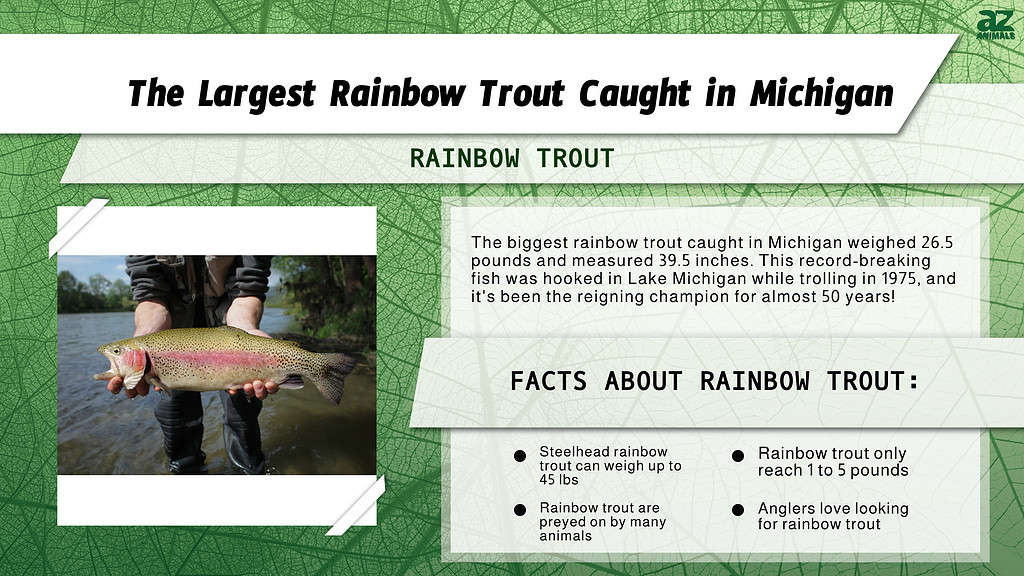
Michigan’s fishing opportunities are endless. There are many fish in Michigan waters, including the vivid rainbow trout. These fish are long, thick, and reach impressive lengths. Can you guess the size of Michigan’s state-record rainbow trout? Follow along to discover the largest rainbow trout ever caught in Michigan.
What is the Largest Rainbow Trout Ever Caught in Michigan?
The largest rainbow trout ever caught in Michigan was 26.5 pounds. This 39.5-inch fish was caught in Lake Michigan by trolling in 1975. It’s held the record for nearly 50 years!
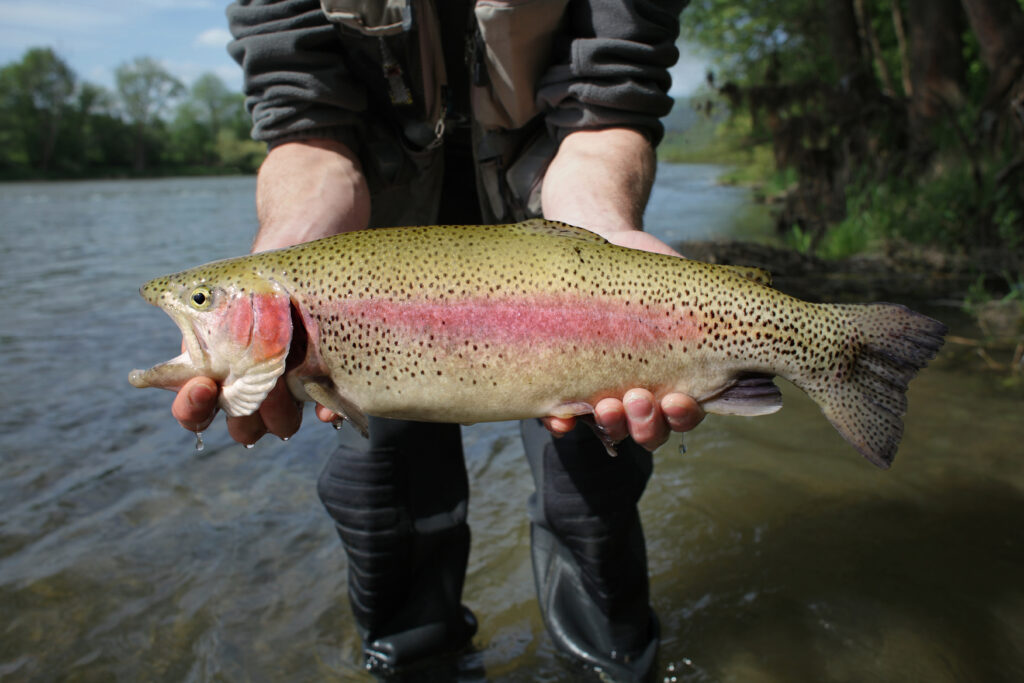
Anglers travel all over North America searching for large rainbow trout to catch.
©pictoplay/Shutterstock.com
About Rainbow Trout
Rainbow trout are beautiful colorful fish with a large range. They are members of the Salmonidae family and are in the genus Oncorhynchus. Other fish in this genus are pink salmon, Apache trout, cherry salmon, and Chinook salmon. Rainbow trout also have many subspecies. Some of these subspecies include the Kamchatkan rainbow trout, Columbia River redband trout, golden trout, Eagle Lake trout, and the Mexican rainbow trout. In Michigan, the rainbow trout found are steelheads.
Size and Appearance
Rainbow trout are thick and long fish. Their size and coloration vary depending on the subspecies. However, most rainbow trout are generally blue-green or olive green with dark spotting. Adults also develop a bright reddish-pink stripe along the lateral line. This red stripe is more noticeable in breeding males.
They also have silver-white bellies. Steelheads, which are the rainbow trout found in Michigan, aren’t as colorful as other rainbow trout types. They are also larger. Steelhead rainbow trout can weigh up to 45 pounds and may grow as long as 45 inches. However, some rainbow trout only reach 1 to 5 pounds and are between 11 and 18 inches long. Their environment plays a role in their size as lake-dwelling rainbow trout are larger than those in riverine environments.

Adult male rainbow trouts have a thick bright red line on their bodies.
©Paul Winterman/Shutterstock.com
Habitat and Distribution
Steelhead rainbow trout are anadromous coastal rainbow trout native to cold-water tributaries of the Pacific basin in Northeast Asia and North America. These lovely fish mainly live in rocky or gravel-bottomed rivers and streams. During spawning, you can find these large fish in lakes and rivers, however, they return to brackish water and the ocean afterward.
Diet
Rainbow trout are excellent hunters. Their diet though changes depending on their size and age. Young juvenile rainbow trout eat zooplankton, while adult rainbow trout mainly eat other fish species and aquatic insects. When hunting, they stay in one spot hidden. The water current rushes food to the rainbow trout.
Predators
Rainbow trout are preyed on by many animals, in both freshwater and saltwater habitats. They are sometimes hunted by fish-eating birds, piscivorous fishes, minks, river otters, and black bears.
Anglers
Anglers love looking for rainbow trout. These vivid large fish are abundant throughout the United States. They are one of the most common trout species in North America. These fish are also easy to catch when spawning as they are abundant. However, rainbow trout can also pose a challenge. Wild trout are sometimes picky and may ignore bait. Every angler swears by a different bait. Some people recommend using live worms or fish, like minnows, while others prefer using artificial bait.
Other Fish in Michigan
Michigan has many fishing lakes, rivers, and ponds. You aren’t limited to just rainbow trout. In fact, other fishes are also common in this state. Follow along to discover other fish you may find in Michigan, including their state records.
American Eel
Starting our list of other fish species in Michigan is the American eel. American eels are native to the eastern North Atlantic Ocean coastline. They are found from Venezuela, all the way to Greenland and Iceland. American eels are bottom dwellers. They are excellent hiders and seek shelter in vegetation, burrows, and under rocks or pebbles. These snake-like fish are long, slender, and thick. They are also smooth and covered in a mucus layer. American eels are large. They can easily reach 4 feet long and weigh 17 pounds. The largest American eel ever caught in Michigan weighed 7.44 pounds. The state-record-holding angler caught this 43-inch-long eel using live shad while on Lake St. Clair in 1990.

The American eel has strong, small teeth to allow it to grip and hold its prey.
©IrinaK/Shutterstock.com
Bowfin
Another fish you can find in Michigan is the bowfin. Bowfins are large bony fish native to parts of North America. These long fish are members of the Amiidae family and are listed as Least Concern on the IUCN Red List. Bowfins are most common in the eastern United States. However, these fish have been stocked in lakes across North America since the late 1800s. Bowfins adapt well to new environments. They live in vegetated rivers, cool streams, brackish waters, large lakes, creeks, and swamps. They are more common in slow-moving water, which they use to hide themselves from predators. Female bowfins are larger than males. Although the average bowfin reaches about 20 inches, they can exceed this. The largest bowfin caught in Michigan was 13.75 inches long and weighed 14 pounds. It was caught in 1981 in Crooked Lake.
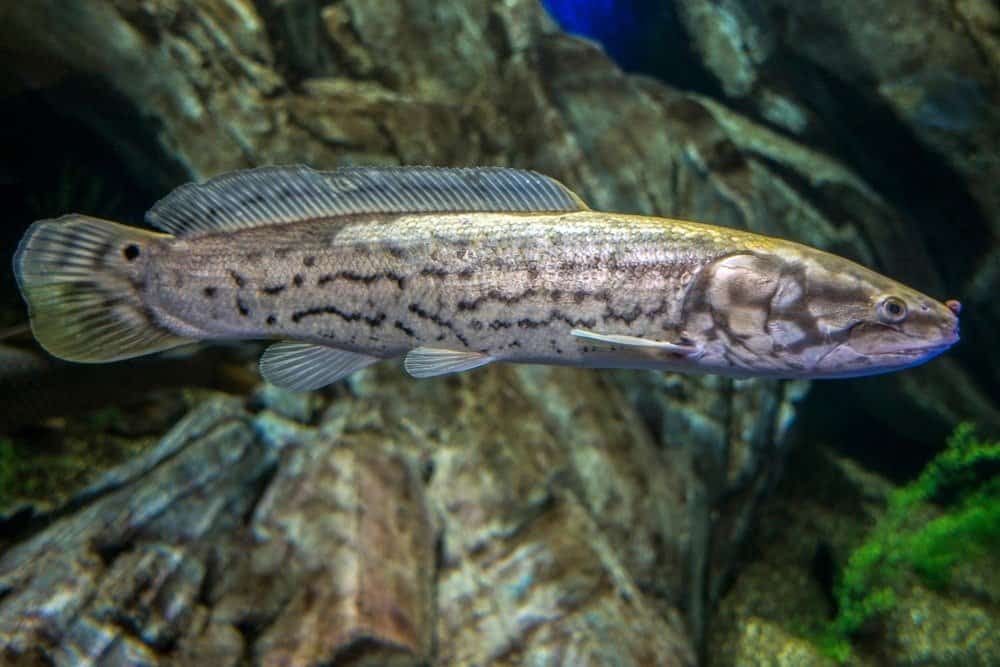
Bowfins are North American fish.
©Miroslav Halama/Shutterstock.com
Lake Whitefish
The next fish on our list is the lake whitefish. Lake whitefish are native to North America. They are freshwater whitefish with a native range of most of Canada and parts of the northern United States. Lake whitefish are favorites for many anglers in the United States as the meat is tender and light. These fish are commonly caught and smoked or grilled. Although most lake whitefish only reach about 4 pounds, they can grow larger. For example, the largest lake whitefish caught in the state was 14.28 pounds. An angler caught this 31.75-inch long whitefish in 1993 by trolling in Lake Superior. This record is close to the world record, which is 15 pounds and 6 ounces.
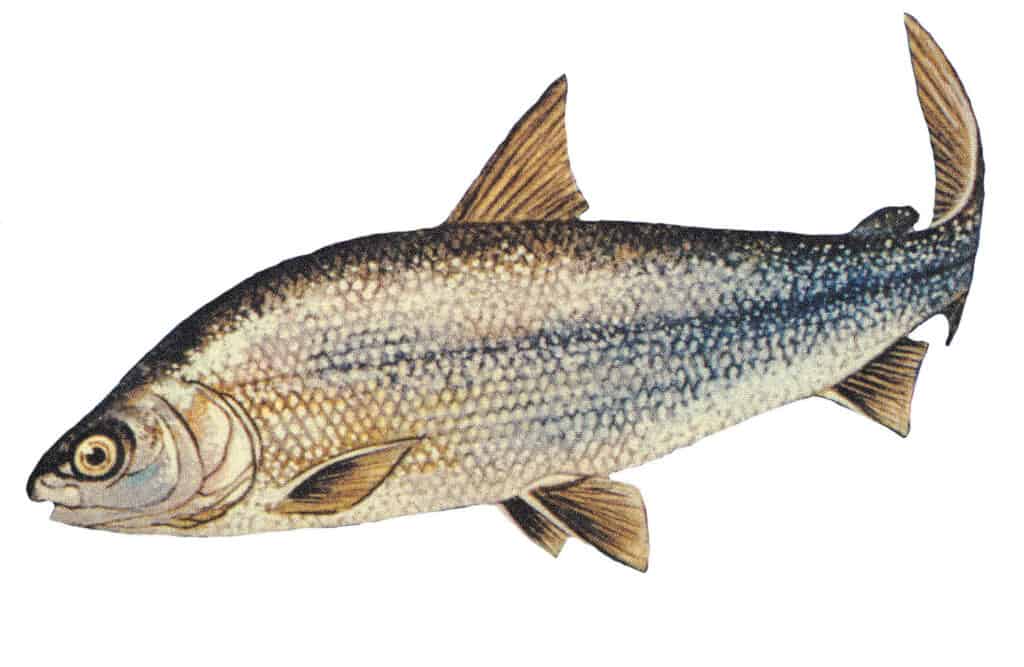
Most lake whitefish only weigh about 4 pounds.
©NOAA Great Lakes Environmental Research Laboratory / flickr – License
Lake Sturgeon
Another fish in Michigan is the lake sturgeon. These fish are powerful, long, and heavy. They are also called rock sturgeons. Lake sturgeons are native to North America. Sadly, unlike the other fish on this list, they aren’t abundant. Instead, they are listed as Endangered on the IUCN Red List. These large, but gentle fish, were once killed in massive amounts because they caused damage to fishing gear. They are also overharvested for their meat and eggs. Lake sturgeon are bottom feeders with bony plates all over their bodies. They have few natural predators and can sometimes measure over 7 feet long. The largest lake sturgeon caught in Michigan was about 7.33 feet long (88 inches). It was 193 pounds and was caught in Mullett Lake.

Lake sturgeon, also known as rock sturgeon, is a freshwater North American fish.
©Geermy/Shutterstock.com
Northern Pike
Last but not least is the northern pike, loved for its massive size and fight. Northern pikes are listed as Least Concern on the IUCN Red List. They are common fish throughout the world with a native range in the Northern Hemisphere. These large fish slightly range in appearance, however, the average northern pike is olive-green or brown. They also have yellow to white bellies and many light spots on their bodies. Northern pikes are thick and long. On average, they are about 16 to 22 inches long. They can also weigh up to 63 pounds. In Michigan, the state-record northern pike is 51.5 inches long and weighs 39 pounds. The world-record northern pike is only a little longer at 59 inches long.
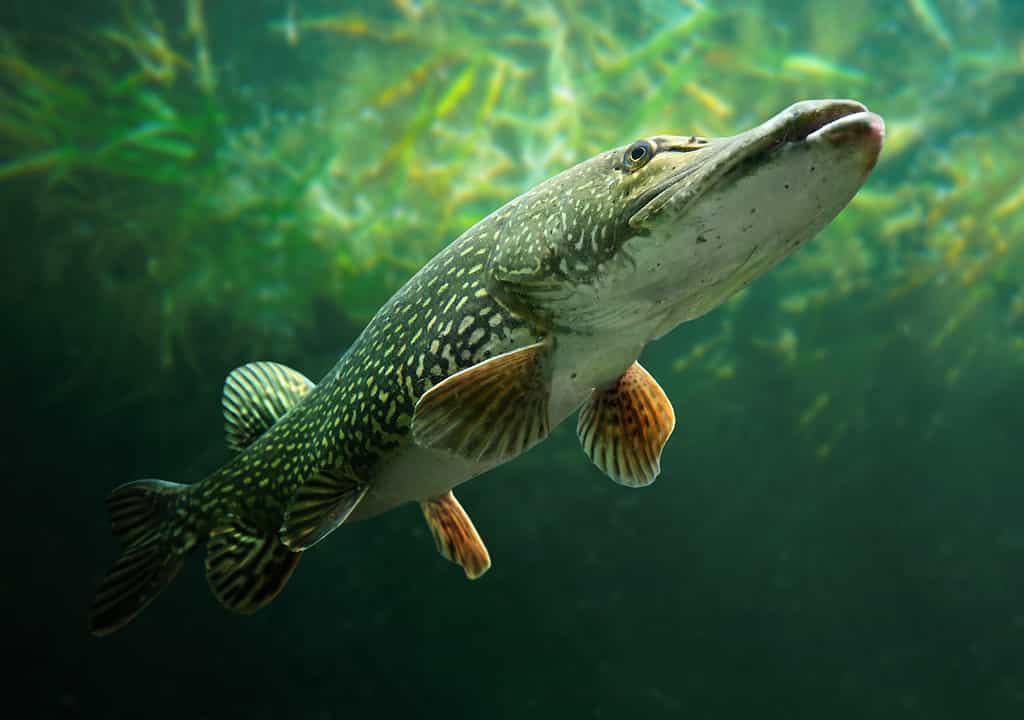
The largest recorded northern pike weighed 63 pounds and was 59 inches long.
©iStock.com/abadonian
The photo featured at the top of this post is © pfluegler-photo/Shutterstock.com
Thank you for reading! Have some feedback for us? Contact the AZ Animals editorial team.







